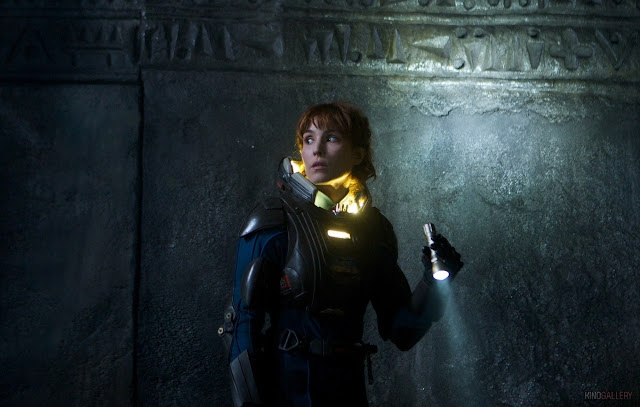 |
| Noomi Rapace (Dr. Elizabeth Shaw) in Prometheus |
This post written by staff writer Megan Kearns originally appeared at Bitch Flicks on June 12, 2012.
[…]
[…]
The radical notion that women like good movies
 |
| Noomi Rapace (Dr. Elizabeth Shaw) in Prometheus |
This post written by staff writer Megan Kearns originally appeared at Bitch Flicks on June 12, 2012.
[…]
[…]
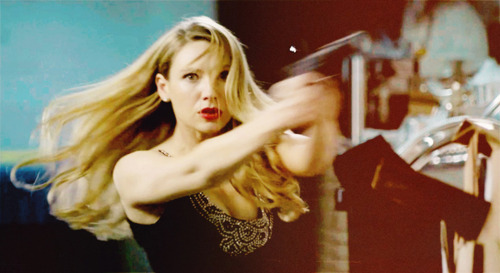 |
| Olivia Dunham (Anna Torv) on Fringe |
She often puts herself in harm’s way to protect those around her and is willing to do anything necessary in the name of justice and fringe science (including having electrical equipment embedded in her skull and then being submerged in an isolation tank.
 |
| Olivia Dunham (Anna Torv) on Fringe in isolation tank |
What I love most is her seemingly inability to be made vulnerable by villains. In several episodes she is rendered unconscious and kidnapped, however, she is hardly ever saved by other people. Although the other members of Fringe are looking for her, she’s the one to smash something against someone’s head or brandish a scalpel as a deadly weapon in order to escape. And it’s not that she busts down doors, guns blazing, but that she knows the appropriate time to do so, or when a lock pick and stealth will suffice.
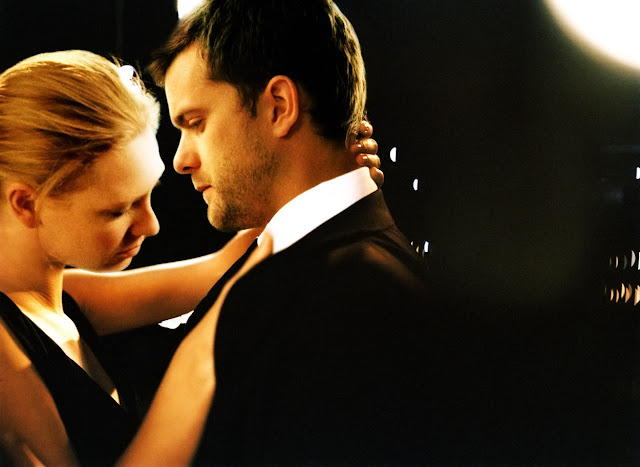 |
| Olivia (Anna Torv) and Peter (Joshua Jackson) on Fringe |
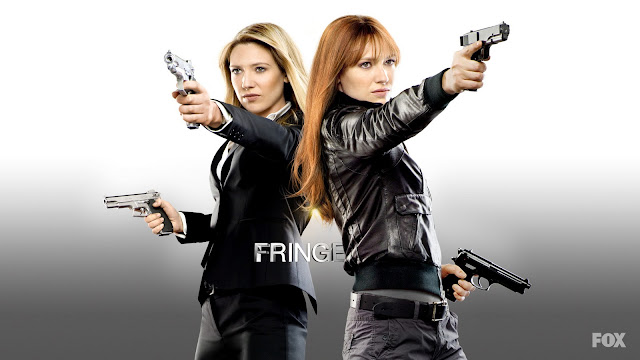 |
| Olivia and Fauxlivia (both played by Anna Torv) on Fringe |
 |
| Sigourney Weaver as Ellen Ripley in Aliens |
When I was 10 years old, the scariest movie I ever saw was Aliens. I remember the first time I saw it like it was yesterday. Late one night, plagued with insomnia (perhaps a product of my tumultuous childhood), I heard the TV on in my mother’s bedroom. Sitting down next to her, I began watching too. My mom was watching Aliens. It was the scene where Ellen Ripley goes down the elevator, guns strapped to her, to rescue Newt. Entranced, I watched as encased in a forklift, she clashed with the Alien Queen.
But it wasn’t the gore or even the alien that mesmerized me. It was Ripley. Seeing a strong badass women on-screen left in an indelible impression on me.
For me, I can’t separate Alien and Aliens (although I pretend the 3rd and 4th don’t exist…ugh). Both amazing films possess pulse-pounding intensity, a struggle for survival, and most importantly for me, a feminist protagonist. Radiating confidence and strength, Ripley remains my favorite female film character. A resourceful survivor wielding weapons and ingenuity, she embodies empowerment. Bearing no mystical superpowers, she’s a regular woman taking charge in a crisis. Weaver, who imbued her character with intelligence and a steely drive, was inspired to “play Ripley like Henry V and women warriors of classic Chinese literature.”
Sigourney Weaver’s role as Ripley catapulted her to stardom, making her one of the first female action heroes. Preceded by Pam Grier in Coffy and Dianna Rigg as Emma Peel in The Avengers, she helped pave the way for Linda Hamilton’s badassery in T2, Uma Thurman in Kill Bill, Carrie-Anne Moss in The Matrix, Lucy Lawless as Xena, Sarah Michelle Gellar as Buffy, and Angelina Jolie in Tomb Raider and Salt. But Ripley, a female film icon, wasn’t even initially conceived as a woman.
 |
| Falling Skies‘ Margaret |
Guest post written by Paul and Renee.
The wonderful thing about science fiction is that the writers have the opportunity to create a world, which while based on ours, can be markedly different. This means that there should be a place for strong female characters who are not restricted by sexism or forced into a situation in which they must perform femininity on a daily basis to be accepted as ‘woman.’ Despite the freedom of this genre; however, nothing is born outside of discourse, which means of course that we end up with the same sexist tropes repeatedly.
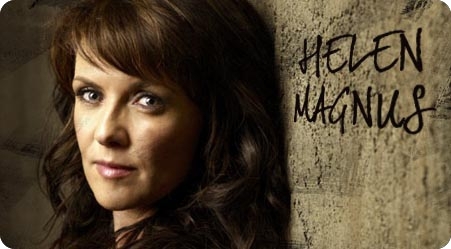 |
| Sanctuary‘s Helen Magnus |
Even when we have strong female characters, they are still not free of damaging tropes. In Continuum, Kiera is strong and is proactive; each week she and her partner Carlos, take turns hunting down the bad guys. Keira is not afraid to get physical if she has to. That sounds great doesn’t it? It would be if that was all I had to say about her, but it seems that once again, a strong female character cannot just be strong. She has to have a vulnerable side and for Keira it’s motherhood. It makes sense that a mother living so far away from her child, would miss her son desperately, but it does not make sense that this sense of loss would turn into her deciding to lecture her grandmother into giving birth and rejecting every legitimate reason she had to have an abortion.
 |
| Continuum‘s Kiera |
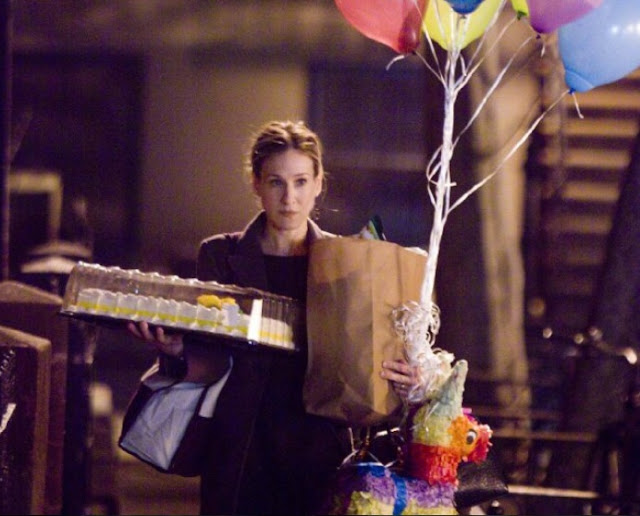 |
||
| Sarah Jessica Parker in I Don’t Know How She Does It |
Guest post written by Kim Cummings. Originally published at her blog Filmmaking, Motherhood and Apple Pie, cross-posted with permission.
 |
| Sarah Jessica Parker and Pierce Brosnan in I Don’t Know How She Does It |
Guest post written by Laura A. Shamas. Originally published at Women and Hollywood, cross-posted with permission.
I have a confession to make. I’m a big softie when it comes to movies. I shed tears at the drop of a hat. But I usually don’t cry during a film trailer. But Beasts of the Southern Wild — both the trailer and the film itself — made me weep.
A strange, haunting, breathtaking dystopian fantasy — it contends with polar ice caps melting, prehistoric creatures, lands flooding, and the bonds of family. With its lush scenes, poignant and complex characters, and achingly beautiful music, it stirred emotions and memories long forgotten. It’s a triumph of the human spirit. And the best part? At the bittersweet film’s center is a little girl.
The film’s female protagonist is Hushpuppy, a 6-year-old African American girl who lives with her father on an island called the Bathtub. And she is a breath of fresh air. Played with depth, nuance and sensitivity, newcomer Quvenzhané Wallis — who’s already generating lots of Oscar buzz — dazzles on-screen. Her luminous personality captivating you at every moment. She’s been called “a miniature force of nature.” And I couldn’t think of a more perfect description. It’s hard to believe Wallis was only 5 years old when she filmed the movie.
Hushpuppy is a pint-sized powerhouse. An indomitable survivor. She’s brave, tough and strong-willed. There’s a fierce intensity, and an old wisdom behind her eyes. Honest, vulnerable and sweet – she is the film’s moral compass, its anchor.
Too often with films with daughters, they merely exist so we can see how the parents react to them. But here, we witness the story unfold from Hushpuppy’s perspective. Director and co-screenwriter Benh Zeitlin said he made a conscious decision to only yield information Hushpuppy has access to. We the audience see only what she sees. She narrates the film throughout so we always know her thoughts and feelings. But honestly, even if you erased all the narration, you would still know because of Wallis’ expressive face and body language. Through her narration, we peek a glimpse into her psyche. Hushpuppy utters poetic and sage musings:
“When it all goes quiet behind my eyes, I see everything that made me flying around in invisible pieces… Everybody loses the thing that made them. The brave men stay and watch it happen. They don’t run.”
“I see that I am a little piece of a big, big universe, and that makes it right.”
Hushpuppy frequently lets out this little scream that reminds me of a warrior cry akin to Xena. It’s as if she’s declaring, “I’m here world. Deal with it.” She carries the weight of the world on her shoulders. Yet there’s a buoyancy to her spirit. Putting animals up to her ear so she can “listen to their innermost desires,” savoring each bite of food she eats…these bring her joyous rapture. Hushpuppy is the film’s moral compass and anchor. We see the whole world through her eyes.
While at times it looks the same, the world in Beasts of the Southern Wild is not ours. The Bathtub was inspired by the real Louisiana island Isle de Jean Charles, which is frequently flooded and is “cut off from the levee system.” Beneath the surface of this strange fantasy, it feels like an allegory of Hurricane Katrina. Although director and screenwriter Zeitlin insists the film is not about Katrina. An apocalyptic fantasy grounded in realism, Zeitlin discussed the film’s message:
“It’s a folk tale about the emotional experience of what it’s like to have to survive the end of your world, and to lose the things that made you.”
Despite his protestations, the parallels between Beasts of the Southern Wild and Hurricane Katrina are uncanny. The film contends with how to survive losing your home amongst horrific destruction and how we shouldn’t turn our back on people. Again feeling like a parallel to the way the government turned its back on Katrina survivors, particularly the survivors of color. The film also contains a strong message of environmentalism. If we continue down the same path of environmental degradation, we may destroy the planet. The philosophy that we are all connected reverberates throughout the film. Especially when Hushpuppy says:
“The whole universe depends on everything fitting together just right. If one piece busts, even the smallest piece…the entire universe will get busted.”
Beasts of the Southern Wild features a disturbing yet loving relationship between Hushpuppy and her ailing father Wink (Dwight Henry), an alcoholic, who vacillates between joyful hope and pained anger. In the beginning, he’s cold and cruel, alcohol warping his lucidity and judgment. He knows he has to take care of her and teach her how to survive in the world. But he seems to resent it as he can barely take care of himself. We eventually see his benevolent streak as he looks for survivors. By the end of the film, I broke down in silent sobs as we witness the strength of their bond.
Too often in film and TV, black fathers are absent, either dead or incarcerated. So it was great that here was a black father. And Henry imbued depth, anger, pain and hope into his character. But why did he have to be so broken? Why can’t we see a positive representation of a black father?
Like many fantasies and fairy tales, we witness an absent mother. But Hushpuppy’s mother’s presence is very much alive. Hushpuppy carries around a sports jersey, a symbol of her mother. She has imaginary conversations with her mother. When she sees a blinking beacon off on the horizon, she believes it’s her mother beckoning her. We also see a maternal figure in Miss Bathsheeba (Gina Montana) who nurtures and cares for all the children of the Bathtub. As her world begins to crumble, Hushpuppy eventually goes in search of her mother. In her journey, Hushpuppy traverses the land with three young girls at her side.
The film boasts strong, resilient, outspoken women and girls. And the stereotypically feminine trait of caretaking is lauded and celebrated. Miss Bathsheeba tells the children that they’ve got to take care for those “littler and sweeter than them…that’s the most important lesson I can teach you.” Wink believes it’s his duty and responsibility to teach his daughter how to survive and take care of herself. Screenwriter Lucy Alibar said he ultimately teaches Hushpuppy:
“How to take care of people. How to take care of someone weaker than you. The strength of kindness. The strength of standing with some place, with your family.”
Sadly, through gendered language, the feminine is often denigrated and demeaned at worst and diminished at best.
Wink often says “man” to Hushpuppy, like “Hey, man.” When they arm wrestle he asks her, “Who’s the man?” To which she proudly replies, “I’m the man.” When Hushpuppy’s house is destroyed – yes, her and her father each have their own house with their own belongings – he draws a line separating Hushpuppy from his sphere, the masculine one. He tells her that no girly toys are allowed on his side, but that he can’t hit her on her own side, something in her favor (Um, what?? Yeah, I’m not cool with violence). Wink often tells Hushpuppy, “No crying,” not allowing her emotions that depict weakness in his eyes. Even when we’re introduced to Miss Bathsheeba (Gina Watson), she’s telling the children not to be “pussies,” something uttered by Hushpuppy herself later in the film.
Food plays an integral role in the film, as sustenance, as a part of culture and as celebration. You see Hushpuppy, her father and their community eating seafood. While it was difficult for me to watch as a vegan, the feminist in me was thrilled that we see a girl eat. In reality, women and girls obviously eat. Due to the media’s policing of female bodies, women and girls have an antagonistic relationship to food. We don’t typically see female characters eating on-screen.
We also see a subtle commentary on gender performance and gender norms. When the residents of the Bathtub are transported to the mainland by the government, Hushpuppy is forced to wear a frilly, girlie-girl dress and tame her wild hair. Stripped of her identity and forced into conformity, she looks miserable. She doesn’t want to be constrained in gender stereotypes. Unconsciously, she wants to perform gender on her terms, not society’s.
I often lament the lack of female-centric films, particularly with women and girls of color. When we do see women, they usually appear as sidekicks or love interests to men. But not here. A black girl is front and center. And even though the film focuses on Hushpuppy’s relationship with her father, her relationship with her mother is equally as important.
We often see boys and men in films that showcase a hero’s journey or transformation. But here – in this film showcasing a triumph of the spirit – we see a journey with a strong-willed, opinionated girl of color. And I couldn’t be more thrilled.
Mystical, ethereal, surreal, touching – Beasts of the Southern Wild is all of these and yet so much more. Even as you watch the film, you might not understand or fully comprehend the meaning of the unusual plot. But let its poetic beauty, emotions and raw honesty wash over you. Let it sink in. For it will be a long time before another film like it – or another female hero as complex as Hushpuppy – comes our way.
 |
| Victory V (Satan), HR Giger, 1983 |
 |
| Biomechanoid, HR Giger,1976 |
 |
| Hermes, Engineer |
Prometheus simplifies what Alien proposed, it interchanges between penile and vaginal imagery: creature with knob-like head that flowers into a vagina, gigantic vagina dentata scene, penis-probe emerges, both male and female genitalia are likely villains. In the proud tradition of a design that’s been rumoured to be inspired by human body bits, skeletons and BMW car parts, it’s all perfectly justifiable.
The eco-feminist opinion of the medicalization of childbirth is that it alienates the child from the mother and vice versa, the mother has to be delivered from her baby, the child has to be saved from its mother’s stifling uterine constrictions, and now I refer quite obviously to Elizabeth’s self-inflicted caesarean. Okay, fine, she didn’t do to herself literally, she got the reluctant machine to do it for her, to get that twisting, bulging, rapidly expanding alien body out of herself. I got an intense feeling of déjà vu during that scene: seriously, get the damned thing out quickly. More painkillers please. The scene has been hailed as a pro-choice metaphor, an assertion of reproductive rights, a claim to ownership of the female body by the female herself, the machine being calibrated for the male body hindering Elizabeth’s attempt to save herself a reference to the ongoing battle for reproductive freedom in the United States, but it is also a modern feminist embrace of medical technology. I agree with the movie’s usage of the term ‘caesarean’; ‘abortion’ would imply a vaginal expulsion of the thing, after killing it within the womb, considerably more invasive and terrifying. Eco-feminism not only gets the boot in that scene with the embrace of mechanistic, but also because Elizabeth, as opposed to cloned Ripley in Alien Resurrection4, isn’t keen to claim any part of the alien growing inside herself as her own.
Prometheus is gorgeous but sports little of the multi-layered psychological profundity of its predecessor (I can barely think of Prometheus as a prequel to Alien, so let’s just say it tried to ride on its predecessor’s glory and it partly succeeded. It has its niggling flaws, like I don’t know why a biologist would approach an entirely new alien species in a ‘here kittykittykitty’ manner, or why with all that fantastic technology the geologist and biologist got lost in the first place. It’s okay, they’re expendable. Elizabeth Shaw however is important and impressive, she’s softer and smaller than the androgynous, tough warrior that is Ripley, however no less formidable as a heroine.
I’m all geared up for a sequel now and want to know how the Engineers are going to react when a female version of themselves lands up at the door with an android’s head in a duffle bag, questioning them about an experiment gone awry.
Notes:
1 Barbara Creed “The Monstrous-Feminine: Film, Feminism, Psychoanalysis”, Routledge, 1993
2 Stanislav Grof “HR Giger and the Soul of the Twentieth Century”, HR Giger, Taschen 2002
3 Jane Caputi, “Goddesses and Monsters: Women, Myth, Power, and Popular Culture”
4 “I’m the monster’s mother”, Ripley, Alien Resurrection (1997)
*Edit 27/6–This is what I assumed the DNA scene from the movie was suggesting. I’m not sciencey enough to know what kind of life forms exist out there or how they come about. When and where the female human is supposed to have come into the picture I can only guess. It was a pretty scene though.
**Edit 4/7–It just occurred to me that this whole thing might be orchestrated by a Queen. Is Ridley going to spring a surprise on us??
 |
| Brave‘s Merida (Kelly MacDonald) via Disney Pixar |
Originally published at Fem2pt0.
Merida (Kelly MacDonald) is a feisty Scottish highland princess. Her mother, Queen Elinor (Emma Thompson – is there nothing she can’t do??), wants her to be poised, articulate, and reserved – a proper princess. Merida wants none of that. A fierce archer, echoing Hunger Games’ Katniss Everdeen, she would rather ride horseback and explore. Her mother wants her to obey the rules and follow tradition. Merida wants the freedom to create her own destiny.
When we see a female lead, they’re usually the only girl or woman, surrounded by dudes as friends or love interests. We rarely see women working together in films, particularly children’s films. Yes, Queen Elinor wants Merida to get betrothed in an arranged marriage. But Merida defiantly rebels against this tradition. There’s no love interest. No romance. No winning the affection of a man. Instead, Merida competes for her own hand in marriage.
Passing the Bechdel Test, Brave captures the loving yet sometimes contentious relationship between mothers and daughters. Director Brenda Chapman was inspired to create the story by her own relationship with her daughter. Often in children’s films, the mother is absent or dead. As if the daughter just sprang from her father the way Athena emerged from Zeus. Now I’m all for single parents. I was raised by a single mom. But it’s disturbing we don’t see mothers. Queen Elinor was never villainized. Both Merida and her mother just want to be heard.
 |
| Merida (Kelly MacDonald) and her mother Queen Elinor (Emma Thompson) |
Something else unusual — something that shouldn’t be strange – you see Merida eat apples. Now, women and girls obviously eat. But you don’t normally witness female characters eating. Due to the media’s policing of female bodies, women and girls have an antagonistic relationship to food. Granted, Merida is still thin. But at least she’s athletic…and eating.
Chapman said she “wanted to give girls something to look at and not feel inadequate.” We’re told as girls and women we’re not pretty enough. We must lose weight or gain weight. We constantly have to control our bodies and ultimately ourselves.
Hair showcases the women’s identities. Merida’s unruly but gorgeous crimson hair symbolizes her rebellious spirit. When her mother dresses her to meet her suitors, she shoves Merida’s hair under a cap. While Merida struggles to loosen at least one curl. Merida doesn’t want to be groomed, perfect or pretty. She wants to be free like her curls. Merida also rips the seams of her confining dress in order to shoot her bow, symbolically breaking free from constrictions and defying tradition. Originally, Queen Elinor’s hair was groomed in thick braids. By the end of the film, her hair flows free and she’s riding a horse with Merida, symbolizing the loss of her rigidity.
Is Brave reducing women and girls to their physical appearances? No, I don’t think so. Instead, by utilizing visual cues (although sometimes the symbolism is a little too on the nose), I think Brave showcases the constraints of gender norms and patriarchy. And more importantly, how we need to break free. Being true to yourself, voicing your opinion and going after your dreams – these are the messages little girls (and boys) need to hear more often.
Is Brave perfect? No. It devolves into a lot of slapstick humor, not really my thing. But the legions of kids attending the 10pm Saturday night showing (really? Isn’t it past their bedtime?) emitted fits of giggles. I also wasn’t thrilled with the gender stereotypes. I appreciated King Fergus (Billy Connolly) and Queen Elinor’s marriage dodged chauvinism and was fairly egalitarian. But men fight and behave buffoonish while women are supposed to be reserved and docile. Both were leaders – the King in battle, the Queen respected in negotiations – but in their gendered spheres. But perhaps that’s the point. It conveys the tradition of patriarchy and how we need to shatter these gender tropes.
But my biggest problem? Brave is still a fairy tale and Merida is still a princess. Are we ever going to get away from princesses? Ever??
Why must we still package female characters for girls in this princess box? Princess culture has saturated – no, make that dominated – our society. Little girls are obsessed with princesses, tiaras, girlie-girl hues of pink and ball gowns.
In her fantastic book Cinderella Ate My Daughter, Peggy Orenstein dissects princess culture and its insidious message of hyperfemininity, sexualization of girls, rescue fantasies and obsession with finding Prince Charming. While princesses don’t necessarily lead to passive girls, they cause girls to feel – not that they can have it all – but that they must be everything to everyone. It’s this pressure of perfection which weakens their self-esteem.
There’s nothing inherently wrong with little girls wanting to look pretty and wear fun clothes. And of course everyone wants to feel special. But it’s problematic princesses are the only role models little girls see in media. Princess culture ultimately objectifies girls, telling them their self-worth lies in their beauty and ability to snag a man.
It’s a huge problem Pixar’s first female protagonist must still be a princess. Don’t get me wrong. Merida is a badass warrior princess who’s defiant, caring, brave and smart. And that’s awesome. But we need to eventually diverge from this princess paradigm and showcase more diversity in female characters.
With the rise of the warrior princess, a fusion of two female archetypes, I hope Brave bridges the old princess movies with a new narrative for girls. Thankfully, Merida herself challenges the princess label and notion of perfection. She’s outspoken, independent and opinionated. We see Merida make mistakes and figure out solutions herself. While she gets help, no one rescues her. Merida doesn’t want to be told how to look, who to marry, or how to behave. She wants to make her own choices. But I worry Hollywood will simply reinforce and perpetuate the princess paradigm, leading to female protagonists who appear empowered but aren’t really.
Brave is absolutely wonderful. Touching and sweet, it brought me to tears, my personal barometer for a great film. And it’s a huge step in the right direction.
A film that reads as a condemnation of patriarchy, I hope Merida leads to different kind of heroine; a truly empowered one. We need to see intelligent and emotionally strong female characters. Who possess career goals and go after their dreams. Who aren’t objectified and whose lives don’t revolve around finding a man.
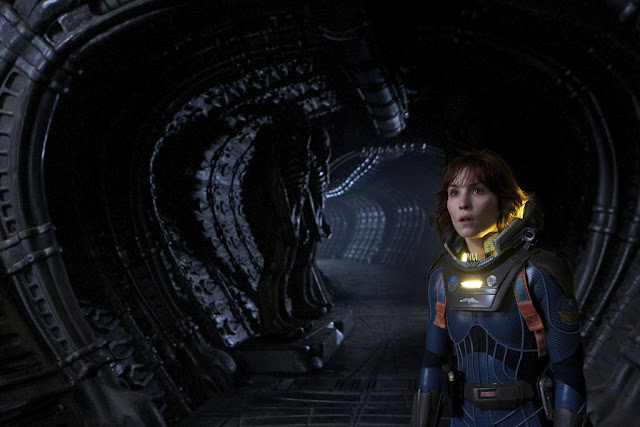 |
| Noomi Rapace as Dr. Elizabeth Shaw in Prometheus |
Guest post written by Rachel Redfern originally published at Not Another Wave. Cross-posted with permission.
The prequel and spinoff for the classic film Alien has as much feminist food as its precursor did, albeit slightly less groundbreaking, though we can’t fault it for that: Alien did give us the first female action hero in Sigourney Weaver’s portrayal of the irrepressible Ripley.
 |
| Greta Gerwig as Lola in Lola Versus |
Romantic comedies usually make me want to gouge my eyes out. Now, that doesn’t mean I hate them all. Some of my favorite films are rom-coms. But every now and again, one comes along that entertains rather than enrages me. Following in the footsteps of female-fronted comedies Bridesmaids, Young Adult and Girls (all of which I love), Lola Versus follows a single woman making horrendously bad decisions yet struggling to find her way.
Supporting Lola through her break-up are her best friends supportive Henry (Hamish Linklater, who I will forever think of as Julia Louis-Dreyfuss’ brother on New Adventures of Old Christine) and scene-stealing sarcastic Alice (Zoe Lister Jones, who also co-wrote the script).
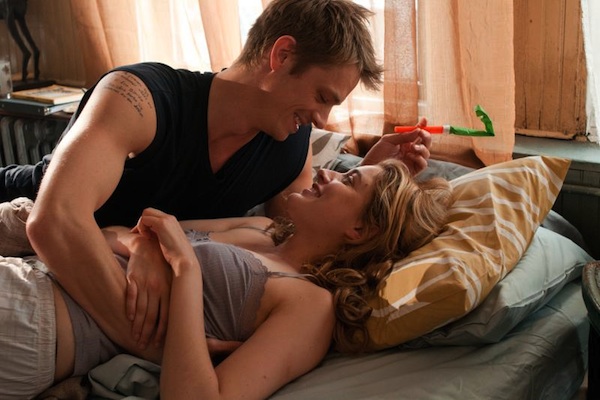 |
| Joel Kinnaman and Greta Gerwig in Lola Versus |
As she tries to move on, we witness Lola ask a man to put on a condom and take a pregnancy test. Not only is it great to see aspects of sex and reproduction. It’s refreshing to see a woman exert her sexuality but not be defined by it merely an object for the male gaze.
While it started off promising, I gotta admit, the bulk of Lola Versus pissed me off. I wanted to shout at the screen, “No, Lola!! Don’t sleep with him!” or “Spend more time with your girlfriends!” or “Don’t believe him that he’s clean…whatever the fuck that means…make him wear a fricking condom!!” or “Stop smoking weed with (and being nice to) your ex-fiancé who dumped you!”
By the end of the film, I realized I wasn’t mad at the movie per se. I was pissed at Lola’s bad choices.
But isn’t that life? Isn’t that what people do when they’re dumped? They obsess over their exes, retracing the steps of their relationship, trying to deciper the clues that led to the relationship’s unraveling. They pine for them. They strategize ways to accidentally run into them (or avoid them like the plague). Either way, there’s a lot of strategizing involved. I wanted Lola to be empowered. To stop obsessing over nice but douchey guys who didn’t appreciate her or who weren’t right for her. I wanted her to hang out with her female friends. But the way the plot unfolded rang more realistic and way more uncomfortable.
 |
| Greta Gerwig and Hamish Linklater in Lola Versus |
In an interview with Collider, Gerwig shared how the script spoke to her because Lola was such a hot mess:
“Sometime female characters, especially in the genre of something that people consider rom-com, make mistakes in a cute way or they’re a mess in a way that’s palatable. I like that Lola is a real mess. She’s making big mistakes and it’s not just cute. It’s destructive and self-absorbed and not awesome and she has to recover from that. She stands to damage relationships around her. Even as this crappy thing happens to her at the beginning of the movie, she uses that as an excuse to behave badly for the next year of her life. I like movies about women behaving badly, because women behave badly just like men, and we’re not always adorable and cute about it.”
Gerwig is absolutely right. Women in film aren’t usually allowed to be messy or unlikeable. Although that’s slowly changing.
Lola Versus made me uncomfortable because it reminded me of too many of the bad decisions I’ve made in my life. Falling back into sleeping with people I shouldn’t. Agonizing and analyzing every single conversation. Calling an ex, desperately hoping to rekindle that spark. Settling for someone not that great in a vain attempt to fill the gaping void that my partner’s disappearance has left.
I eventually stopped all this time-sucking nonsense. I thought by hanging onto relationships, I was boldly forging ahead seeking my happiness. But that’s not what I was really doing. I was placing my happiness in the hands of others. And so was Lola.
 |
| Zoe Lister Jones and Greta Gerwig in Lola Versus |
The movie tackles the topic of single women and aging. As we approach or pass turning 30 (like me!), we contend with societal expectations. Not that turning 30 is some horrible harbinger of doom. Quite the contrary. I’ve been more confident and comfortable in my own skin after turning 30. But it’s still hard to silence the social cues that tell us our lives should fall into place in a certain pattern.
Here’s the thing about Lola Versus. It frustrated me and I rarely laughed out loud. Although the scene where she screams at the party…priceless. But Gerwig mesmerized me and the film enthralled me. It passes the Bechdel Test (yay!!!). And it boasts one of the absolute best endings I’ve ever seen in a film. Ever.
In every romantic comedy, it’s all about two people getting together in the end. Or if it’s really radical — and trust me, I use that term facetiously — they’re already together in the beginning and it’s about the two lovers facing obstacles but ultimately staying together. The only rom-coms I can recall that deviate from this predictable paint by numbers path are Annie Hall, The Break-Up and Kissing Jessica Stein.
I don’t want to spoil the ending. But I will say this. (Aver your eyes if you want to be completely surprised) Lola achieves happiness, something that had eluded her all along. She suffered writers’ block, not being able to silence the voices and noises in her head — ironic since her dissertation was analyzing silence in film — but now she could write again. She became happy with who she was and with her life.
And it had nothing to do with a man.
Now that doesn’t mean she says fuck you to all her relationships. While she knew how to love other people, she didn’t know how to love herself, a lesson most of us need to learn.
Lola talks about Cinderella with her mom (Debra Winger…so glad to see her in more films!). She tells her that she liked Cinderella as a kid but how fairy tales are toxic, teaching girls to wait for a man to sweep them off their feet and give them shoes. Fairy tales set women up for failure. We put these unrealistic expectations on love and romance. Now, I’m not arguing for settling, not by any means. But fairy tales teach girls that when they grow up, they should wait around for men; that they should put romantic relationships before everything else in their life even sacrificing themselves. Lola realizes that she must navigate her own happiness rather than relying on a man or some lofty romantic fairytale.
Too many romantic comedies subject women to stereotypical gender roles. Needy, passive, just out to find a man. Can’t romantic comedies be intelligent? Can’t they highlight the importance of female friendship too?? Yes, yes they can. And Lola Versusdoes.
One of my favorite lines in the film is when Lola says:
 |
| Noomi Rapace (Dr. Elizabeth Shaw) in Prometheus |
Warning: massive spoilers ahead!
For those who discount Shaw’s abortion because it’s a foreign object or not a traditional fetus, look at Breaking Dawn. Bella’s vampire/human fetus grew at a rapid rate, made her sick and almost destroyed her body. Yet she chose to keep it. My point is that Shaw could have as well. Instead, she chooses an abortion.
 |
| Dr. Elizabeth Shaw (actor Noomi Rapace) after having abortion in Prometheus |